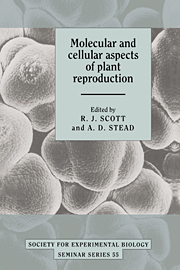Book contents
- Frontmatter
- Contents
- List of Contributors
- Introduction: ‘Where do we go from here?’
- Molecular control of floral organogenesis and plant reproduction in Petunia hybrida
- Control of floral morphogenesis in cauliflower (Brassica oleracea L. var. botrytis): the role of homeotic genes
- Isolation and properties of mutants of Arabidopsis thaliana with reduced sensitivity to short days
- Asexual mutants in Melandrium album (Silene alba): tools in cDNA cloning and analysis of an X/Y chromosome system in plants
- Pollen exine – the sporopollenin enigma and the physics of pattern
- The diversity and regulation of gene expression in the pathway of male gametophyte development
- Characterisation of Arabidopsis thaliana anther-specific gene which shares sequence similarity with β-1,3-glucanases
- Ovule cDNA clones of Petunia hybrida encoding proteins homologous to MAP and shaggy/zeste-white 3 protein kinases
- Towards the elucidation of the mechanisms of pollen tube inhibition during the self-incompatibility response in Papaver rhoeas
- Intracellular movement and pollen physiology: progress and prospects
- Organisation and functions of cell surface molecules on gametes of the brown algae Fucus
- Strategies of flower senescence – a review
- The physiology of petal senescence which is not initiated by ethylene
- Molecular biology of flower senescence in carnation
- Ethylene sensitivity and flower senescence
- Ethylene biosynthetic genes and inter-organ signalling during flower senescence
- Index
Introduction: ‘Where do we go from here?’
Published online by Cambridge University Press: 04 August 2010
- Frontmatter
- Contents
- List of Contributors
- Introduction: ‘Where do we go from here?’
- Molecular control of floral organogenesis and plant reproduction in Petunia hybrida
- Control of floral morphogenesis in cauliflower (Brassica oleracea L. var. botrytis): the role of homeotic genes
- Isolation and properties of mutants of Arabidopsis thaliana with reduced sensitivity to short days
- Asexual mutants in Melandrium album (Silene alba): tools in cDNA cloning and analysis of an X/Y chromosome system in plants
- Pollen exine – the sporopollenin enigma and the physics of pattern
- The diversity and regulation of gene expression in the pathway of male gametophyte development
- Characterisation of Arabidopsis thaliana anther-specific gene which shares sequence similarity with β-1,3-glucanases
- Ovule cDNA clones of Petunia hybrida encoding proteins homologous to MAP and shaggy/zeste-white 3 protein kinases
- Towards the elucidation of the mechanisms of pollen tube inhibition during the self-incompatibility response in Papaver rhoeas
- Intracellular movement and pollen physiology: progress and prospects
- Organisation and functions of cell surface molecules on gametes of the brown algae Fucus
- Strategies of flower senescence – a review
- The physiology of petal senescence which is not initiated by ethylene
- Molecular biology of flower senescence in carnation
- Ethylene sensitivity and flower senescence
- Ethylene biosynthetic genes and inter-organ signalling during flower senescence
- Index
Summary
The articles in this volume provide a stimulating overview of several aspects of current research in plant reproductive biology. Some convincingly illustrate how age-old problems of plant reproductive systems are proving to be accessible to the awesomely powerful methods of molecular biology, while others show how this approach can complement – and be complemented by – other new techniques for investigating intracellular processes and cellular interactions at levels beyond that of the gene. In the light of these many current developments, it is surely not overly optimistic to suggest that we are entering a new era in the exploration of plant reproductive phenomena.
So, in what directions might research be expected to progress now? While defining priorities is always fraught, it is at least permissible to attempt to identify a few parts of this very wide subject where there is a real promise that some of the outstanding problems could yield to the application of the new methodologies. In this connection it is important for the plant scientist to keep an eye on what is happening in animal and microbial cell biology; after all it is from these much more fully populated and much better resourced fields that we borrow most of our technology. We need also to bear in mind that sexual reproduction in plants involves essentially all the basic processes of development: cell nutrition, division, growth and communication, tissue differentiation and organ morphogenesis.
- Type
- Chapter
- Information
- Publisher: Cambridge University PressPrint publication year: 1994



